Boeing 737-300
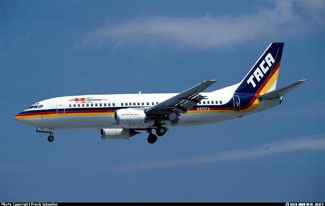
Photo copyright Snorre - used with permission
TACA International Airlines Flight 110, N75356
New Orleans, Louisiana
May 24, 1988
On May 24, 1988, a Boeing Model 737-300, N75356, owned by Polaris Aircraft Leasing Corp. and operated by TACA International Airlines as Flight 110 from San Salvador, El Salvador with a stop in Belize City, Belize, made a forced landing on a levee near New Orleans, Louisiana, following a dual engine flameout. The airplane encountered extremely severe weather at about approximately 16,500 feet during descent near New Orleans, Louisiana. There were no injuries reported from the 38 passengers and seven crew. The National Transportation Safety Board determined that the ingestion of large amounts of water and hail during a thunderstorm encounter caused the dual engine flameout.
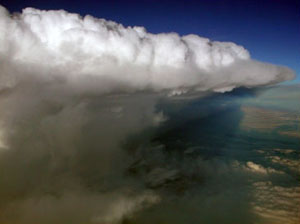
History of Flight
TACA International Airlines Flight 110 was a regularly scheduled passenger flight between San Salvador, El Salvador, to New Orleans, Louisiana with an en route stop in Belize City, Belize. The airplane, a Boeing Model 737-300 with 38 passengers and a crew of seven on board, departed as scheduled from Belize City, and the flight was uneventful until descent into New Orleans from 35,000 feet.
During descent from 35,000 feet for landing into New Orleans Airport, the aircraft encountered severe weather. The flight crew attempted to avoid the most severe storm cells but penetrated momentarily into massive precipitation.
At approximately 16,000 feet, the airplane encountered 30 seconds of heavy hail, resulting in both engines experiencing a simultaneous complete power loss, following a thrust roll-back. The flight crew declared an emergency at 12,000 feet and radioed air traffic control (ATC) "we're in the middle of the storm....we lost an engine".
The flight crew attempted to windmill restart both engines but were unsuccessful. The flight crew then started the auxiliary power unit (APU), and was attempting to relight both engines using starter assist. In the start attempts, the engines successfully ignited, but due to the continuing presence of high concentrations of water and hail, did not accelerate to idle. The flight crew, recognizing there was no engine thrust response to throttle commands, elected to shut down both engines and prepare for an emergency landing.
The flight crew realized that a landing was not possible at the airport and started preparations to ditch. After breaking out of the cloud layer they were able to identify a small levee and were able to make a successful off-airport dead-stick landing on the levee. There were no injuries.
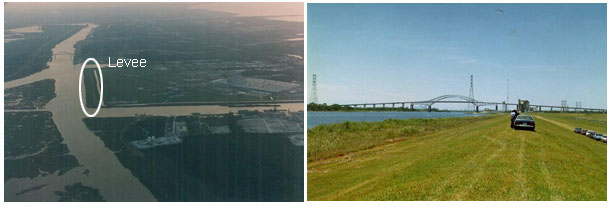
Photo of ground view of levee (right) - NTSB docket photo
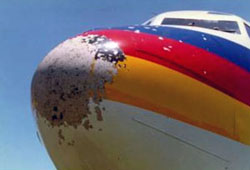
- NTSB Docket Photo
Engine Response to Heavy Precipitation
Investigation into the cause of the dual-engine flameout indicated the aircraft, while descending at low engine power and high airspeed, had encountered an area of intense rainfall followed by 30 seconds of heavy hail. The storm intensity, stated in terms of liquid water content (LWC), was estimated to be 25 to 30 grams per cubic meter, which equates to a rainfall rate of approximately 30 inches per hour. LWC is expressed in terms of the ratio of water content per volume of air, in this case grams of water per cubic meter of air.
Investigators determined that the cause of the dual-engine flameout was the ingestion of hail into the engine core. Subsequent testing revealed that, unlike rain, hail is much more effective at entering the engine core. Hail can more easily pass between the fan blades and directly enter the core, or it will bounce off the fan spinner and be deflected past the fan blades into the core.
An inlet is intended to diffuse the air flow into the engine and at high speed, slow the incoming air to align it to the fan blades. The airflow path can be influenced by the inlet and may curve relative to the airplane flight path. Unlike air, and to some extent liquid water, hail behaves in a more ballistic manner (like a bullet), and is not influenced by the diffusion effects of the inlet, maintaining a more direct path into the fan. At certain combinations of fan rotational speeds and airplane speeds, a higher concentration of hail can enter the engine, as compared to rain at the same conditions.
Weather Radar
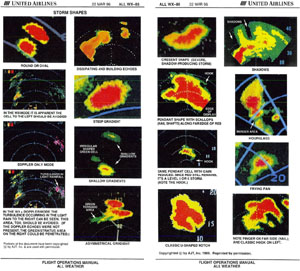
Photo copyright Ajt, Inc - used with permission
View Larger
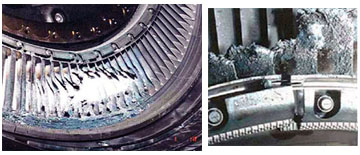
Modern jet transports are equipped with weather radar that displays information regarding the intensity of weather in the vicinity of the airplane. Weather radar is intended to provide the pilots with a depiction of weather in front of the airplane, and may influence flight path decisions if weather of sufficient intensity is in front of the airplane. Flight crews may decide to alter the airplane flight path based on the intensity of approaching weather. Displays typically show green for lowest intensities of weather, graduating to amber and red as intensity increases. Red areas indicate the most intense precipitation and are to be avoided. Areas where no precipitation is "seen" by the radar are displayed as black, or the same color as the display background. However, when displaying extreme precipitation levels, the radar may display the highest intensities (worse than red) as "clear" on the radar screen. This is commonly known as a "radar shadow" and is a result of attenuation of the radar signal.
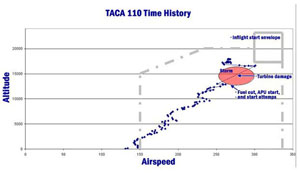
on B737 in-flight start envelope
View Larger
Flight crews are also able to select the range to look ahead of the airplane. Range can be set as low as 5-10 miles, and perhaps as distant as 160 miles. Selection of radar range settings is important to provide the pilots the best short- and long-range picture of weather in the vicinity of the aircraft. The image on the left is a selection of sample airplane weather radar images (for example, the top right image shows a radar shadow).
Flight Crew Actions
The attempted windmill restart of both engines, due to low high pressure spool speeds (N2), in combination with continued water ingestion, resulted in excessive exhaust gas temperatures (EGT), and led to destruction of turbine components. For the TACA event, the CFM56 engine windmill in-flight restart envelope, like other turbofan engines, is based on starts in clear air conditions. However, the CFM56 windmill relight envelope is relatively small when compared to other turbofan engines of the same class.
The flight crew was successful in getting both engines to relight using the APU starter assist. However, the start sequence did not progress properly (i.e., accelerate to stable idle speeds) due to continued heavy rain ingestion. This resulted in EGTs which exceeded "red-line limits" and melted turbine components. Post-incident investigation by the engine manufacturer (CFMI) determined that it is more difficult to start an engine in precipitation than it is to continue to run during the same precipitation.
Hail Ingestion Effects
As a result of this incident, extensive testing was conducted to better understand the effects of hail ingestion on turbine engine behavior. Prior to this incident, there was widespread belief that water and hail behaved similarly when ingested into an engine. However, investigators learned that hail behaves significantly different than water when passing through an engine fan and entering the core of a turbofan engine.
Severe hail ingestion into an engine can cause adverse engine operation, such as flameout or roll-back, due to an excessive water-to-air ratio in the engine core. There are factors which contribute to the relative severity of hail ingestion effects. These include:
- High airplane altitude increases the hail-to-air ratio
- Low fan speed, rotations per minute (RPMs), promotes hail ingestion into the core
- High fan speeds tend to centrifuge hail away from the core
- High aircraft airspeeds increases the hail-to-air ratio
- At some fan speeds and aircraft air speed combinations, ingestion into the core is greatly increased (hail misses the fan blades and goes directly into the core, commonly called the Venetian blind effect)
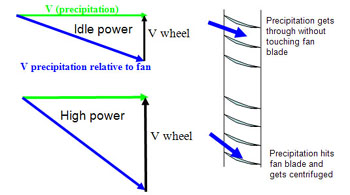
When the water-to-air ratio becomes sufficiently high, it overcomes the fuel-to-air ratio required for stable combustion, and subsequently results in an engine flame-out. Essentially there is too much water passing through the engine core to maintain combustion. Once the engine fails, it cannot be restarted until the water-to-air ratio decreases to a point where the fuel-to-air ratio can once again maintain combustion.
Engine Ingestion Testing
At the time the CFM56 engine was evaluated, the FAA engine hail ingestion requirements were focused on foreign object damage (FOD) to engine hardware and not engine operability effects. It was believed that conducting a severe rain ingestion test was the critical environment, and the results could also be applied to operation in continuous hail conditions. The unique behavior of hail relative to turbofan engine compressor components was not well understood at the time. It was believed that the primary threat posed by hail was foreign object damage. In addition, the method used to test some engines, involving low simulated airplane speed and high engine rotational speeds, tended to centrifuge water away from the core, thus failing to duplicate actual, critical in-flight conditions, such as those faced in the TACA incident.
The investigation estimated that the storm encountered by the TACA aircraft was the same rain intensity as that required by the engine certification standards. However, certification testing conducted on the CFM56 engine was performed with a substantially greater amount of water than was required by the regulations. Although these test demonstrated a 400% margin, they were later found to be incorrect due to the testing methods involving low airplane speed and high engine rotational speeds which tended to shield the core (i.e., centrifuging of water away from the core).
Subsequent Design Changes
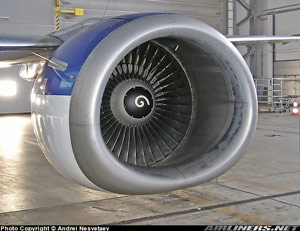
Photo copyright Andrei Nesvetaev - used with permission
Following the TACA event, CFMI conducted an extensive investigation that included multiple engine tests and detailed analysis. These tests produced a greater understanding of the behavior of hail in the compressor of the CFM56 engine, and led to several design changes.
The objective of these design changes was to increase the engine's ability to continue to run in heavy concentrations of hail and water, and included the following:
- Spinner profile change from conical to a combination elliptical and conical (spinner shape called coniptical) to guide the hail radially outward
- Cutback splitter that allows more ingested rain and/or hail to be centrifuged out by the fan rotor, away from the core, and into the fan bypass flow
- Increased number of variable bleed valve (VBV) doors that allowed additional rain and/or hail to be extracted from the core flow path at low engine rotational speeds
View an animation detailing the various changes below:
The FAA issued Airworthiness Directives (AD) to mandate these design changes on the CFM56 engines, and mandated Boeing 737 airplane flight manual procedure changes.
CFMI also identified and incorporated additional design changes in their follow-on engine designs that provided improvements in operation in inclement weather. These included:
- Adaptive engine start logic for Full Authority Digital Electronic Controlled (FADEC) engines (the TACA engines were not FADEC controlled). Adaptive start logic improves the starting performance, and reduces the risk of engine damage during a start sequence.
- Introduced improvements to the flow path contour (i.e., S - shape turn) to increase the effectiveness of VBV doors to remove material from the core flow path.
This event was not categorized as an aircraft accident by the NTSB so an official accident report with NTSB findings was not issued. However, the NTSB issued a factual report No. FTW88IA109 dated Sept. 7, 1990, and a Brief of Incident dated March 25, 1991, with the following findings on this event:
"The National Transportation Safety Board determines the probable cause(s) of this incident as follows.
"A DOUBLE ENGINE FLAMEOUT DUE TO WATER INGESTION WHICH OCCURRED AS A RESULT OF AN INFLIGHT ENCOUNTER WITH AN AREA OF VERY HEAVY RAIN AND HAIL. A CONTRIBUTING CAUSE OF THE INCIDENT WAS THE INADEQUATE DESIGN OF THE ENGINES AND THE FAA WATER INGESTION CERTIFICATION STANDARDS WHICH DID NOT REFLECT THE WATERFALL RATES THAT CAN BE EXPECTED IN MODERATE OR HIGHER INTENSITY THUNDERSTORMS."
This event was not categorized as an aircraft accident by the NTSB, therefore, an official accident report with NTSB recommendations was not issued.
The following relevant regulation was in affect at the time of the CFM56-3 certification:
14 CFR §33.77 Amendment 6 (1974) - "Foreign Object Ingestion".
- Bird ingestion - small, medium, large (FOD)
- Ice ingestion - shed encounter from the inlet (FOD)
- Hail ingestion - volley based on inlet area (FOD)
- Water ingestion - ingested at 4% engine airflow (continue to run during three-minute ingestion)
- Gravel/Broken Rotor/Tire tread - FOD/containment
At the time of this accident, there was a widespread industry belief that addressing the threat posed by high concentrations of rain also addressed the "continue-to-run" threat posed by hail. Hail was viewed primarily as a FOD threat and was not considered to be a significant threat that would affect an engine's ability to continue to run if it had not experienced hail impact damage.
- Severe hail and rain encounter led to a dual-engine flame out. The CFM56 engine proved to be vulnerable to high concentrations of hail.
Some of the key design and safety assumptions that proved to be flawed in this event are listed below.
Actual engine certification properly simulated severe storm conditions:
- Mismatched inflow stream tube speed/fan speed during testing resulted in very little water reaching the core. This issue was not recognized prior to the TACA event.
- The engine demonstrated a four times margin compared to certification requirement, which may have given a false sense of security.
Rain was considered the primary "continue-to-run" threat per the regulations.
Hail was only considered to be a FOD threat and not an operability threat:
- Large hail particles are less influenced by the flow stream, and may pass through the fan and concentrate in the core.
- Hail can also bounce off of solid surfaces such as a spinner and enter the core.
Engines would not be damaged and would restart after exiting the extreme weather.
Pilots would successfully avoid extreme weather.
Note that at the time of the CFM56 certification, the service experience supported these assumptions.
Air Europe B737-300 airplane, Flight 579 approaching Salonica, Greece with CFM56-3 engines experienced a simultaneous dual-engine flameout during descent at 8,900 feet on August 21, 1987. Important factors include:
- Aircraft was in light to moderate turbulence, moderate to heavy rain, and sudden intense hail when the flameouts occurred. Pilot reports "wall of ice." Flameouts not recognized at first.
- Both engines were windmill started and the aircraft landed uneventfully.
- Investigation into the cause of the flameouts concluded that extreme weather exceeded the flameout margin of the engine, and that the water concentration encountered has a low probability of occurrence. Focus was primarily on rain and not on hail.
- First known report of thrust loss in severe precipitation in the Boeing 737 (CFM56) fleet. (More than three years of revenue service, 40 operators, and approximately 1.5 million aircraft flight hours).
Industry Reaction
When the TACA event occurred, the industry and FAA were starting to recognize engine power loss in inclement weather as a safety threat to the aircraft. An Aerospace Industries of America (AIA) task force was organized with representatives from airframe and engine manufacturers to investigate multiple engine power loss in inclement weather.
The FAA and industry worked together to study this threat and eventually revise the corresponding FAA certification standards for turbine engine rain and hail ingestion. The results of the study indicated there were a number of multiple turbine engine power loss and instability events, forced landings, and accidents in revenue service attributed to operating airplanes in extreme rain or hail conditions. Investigations revealed that ambient rain or hail concentrations can be amplified significantly through the engine core at high flight speeds and low engine power conditions. Rain or hail through the engine core may degrade compressor stability, combustor flameout margin, and fuel control run down margin. Ingestion of extreme quantities of rain or hail through the engine core may ultimately produce engine surging, power loss, and engine flameout. In 1998 a revised FAA engine rain and hail standard was issued as 14 CFR §33.78.
Prior to the new standard becoming a rule, industry began complying with the revised standards. The following are recent videos of an engine hail ingestion and water ingestion FAA certification tests that was conducted to the revised certification standards. These videos show an example of the GE90 hail and rain ingestion testing that are completed as part of the FAA certification process.
As a result of the TACA event, the following regulatory changes were made:
1) 14 CFR §33.77 Amendment 19 (1998) - "Foreign Object Ingestion"
Retained:
- Bird ingestion - small, medium, large (FOD)
- Ice ingestion - shed encounter from the inlet (FOD)
Removed:
- Hail ingestion - volley based on inlet area (FOD)
- Water ingestion - ingested at 4% engine airflow (continue to run during three-minute ingestion)
- Gravel/Broken Rotor/Tire tread - FOD/containment
2) 14 CFR §33.78 Amendment 19 (1998) - "Rain and hail ingestion"
- Increased severity for water ingestion tests (i.e., rain and hail)
- Implemented by engine manufacturers from 1989 onward
- Implemented new test standard based on a 1 x 10-8 storm encounter
- Issued new Advisory Circular 33.78-1 to supplement the new §33.78 rule
3) 14 CFR §B33.1 Amendment 19 (1998) - "Certification standard atmospheric concentrations of rain and hail"
- Added Appendix B defining the rain and hail concentrations
Several Airworthiness Directives (AD) were issued following the TACA event:
1) Telegraphic AD T88-11-51 issued on May 30, 1988
- Revises the B737-300 airplane flight manual procedures to reduce the possibility of engine flameout in severe rain and hail conditions. These actions were considered interim actions until final corrective actions were defined and included.
2) Telegraphic AD T88-13-51 issued on June 14, 1988
- Superseded Telegraphic AD T88-11-51
- Required a revision to the Limitations Section of the AFM to require operation with a minimum Ni engine speed of 45 percent, engine ignition in the FLIGHT position when flying in moderate to severe precipitation, and a cautionary note advising that flight in moderate to severe thunderstorm activity is to be avoided.
3) AD T88-11-51 issued on October 6, 1988.
- Requires revision to the airplane operation limitations when flying in moderate to heavy precipitation to prevent potential engine flameouts.
4) AD T88-11-51 issued on December 1, 1988.
- Clarifies AFM wording and installation
5) AD 89-25-02 issued on November 15, 1989.
- Requires modification of the engine idle circuitry to inhibit the in-flight low idle capability. Increase the engine minimum percent N1 flight idle and increases the engines flameout margin and reducing the possibility of engine flameout during heavy precipitation. For B737-300 and 400 series airplanes.
6) AD 91-02-10 effective on February 11, 1991.
- Requires installation of a new fan splitter, fairing, and new VBV configuration on CFM56-3 engines to prevent power loss or flameout in heavy precipitation. Incorporates by reference CFMI SBs: 72-450 R1 and 72-462 R1.
7) AD 93-05-05 issued April 29, 1993.
- Requires an update to aircraft flight manual of certain B737 model airplanes to include procedures for operation in inclement weather.
Airplane Life Cycle:
- Design / Manufacturing
- Operational
Accident Threat Categories:
- Inclement Weather / Icing
Groupings:
- Approach and Landing
Accident Common Themes:
- Flawed Assumptions
Flawed Assumptions
The FAA and industry assumed that the engine certification properly simulated severe storm conditions. They also only considered hail as a foreign object damage (FOD) threat and that rain ingestion was the primary operational threat. It was also assumed that engines would resist damage during the threat and be able to operate normally after the threat was passed.
Continental Airlines Boeing Model 737
On July 26, 1988, a Continental Airlines Boeing 737 with CFM56-3 engines experienced a single engine flameout during initial descent through 19,200 feet.
This event occurred after the TACA event and was not a precursor to TACA but was another event of an engine power loss attributed to inclement weather. This aircraft suddenly encountered moderate turbulence and very heavy rain when the flameout occurred.
Garuda Boeing Model 737-300
On January 16, 2002, a Garuda Boeing 737-300 experienced a dual-engine flameout at 18,400 feet in intense rain/hail in Solo City, Indonesia. The flight crew was unable to restart the engines. The aircraft ditched in a river, resulting in one fatality. The flight crew was navigating through severe weather but turned the aircraft directly into a thunderstorm. The weather radar displayed what appeared to be a clear path through the storm. In fact, weather radar displays can display misleading information, showing highest intensity areas (worse than red) as "clear." Pilots may perceive a gap in the weather where none exists.

Technical Related Lessons:
Turbine engines must be capable of operation in a wide range of atmospheric conditions, including severe hail and rain. (Threat Category: Inclement Weather/Icing)
- All-engine flameout events due to environmental threats and other causes may occur at a very low probability during the life of the fleet. Engine design standards for an environmental threat, such as hail, are driven in part by the probability of encountering a hailstorm of a certain severity. This approach recognizes that there are hailstorms of greater severity that may be encountered (at a very low probability) during the life of the fleet, and that these storms must be avoided.
Flight crew training should include information regarding the performance and inherent limitations of onboard weather radar systems. (Threat Category: Inclement Weather/Icing)
- In this event, a contributing factor was the weather radar display, which appeared to show a path through the severe weather. In fact, the seemingly clear path was the result of the radar's inherent inability to depict weather beyond its saturation limits (beyond "red"). Since this event, information has been distributed to flight crews, and training programs initiated, aimed at providing information on the limitations of weather radar systems and how severe weather may be depicted.
Common Theme Related Lessons:
Past assumptions must be confirmed as relevant to present designs. It is necessary to understand the origins of original assumptions before they can continue to be considered valid. (Common Theme Category: Flawed Assumptions)
- An underlying assumption made in the CFM56 design was that the hail threat was considered adequately addressed by accommodating the threat posed by heavy rain concentrations. Extensive testing following this event discovered that hail behaved very differently than water when entering the inlet. As such, specific design changes would be necessary to be made to the CFM-56 engine in order the improve the engine's ability to continue operating in certain high concentrations of hail.
